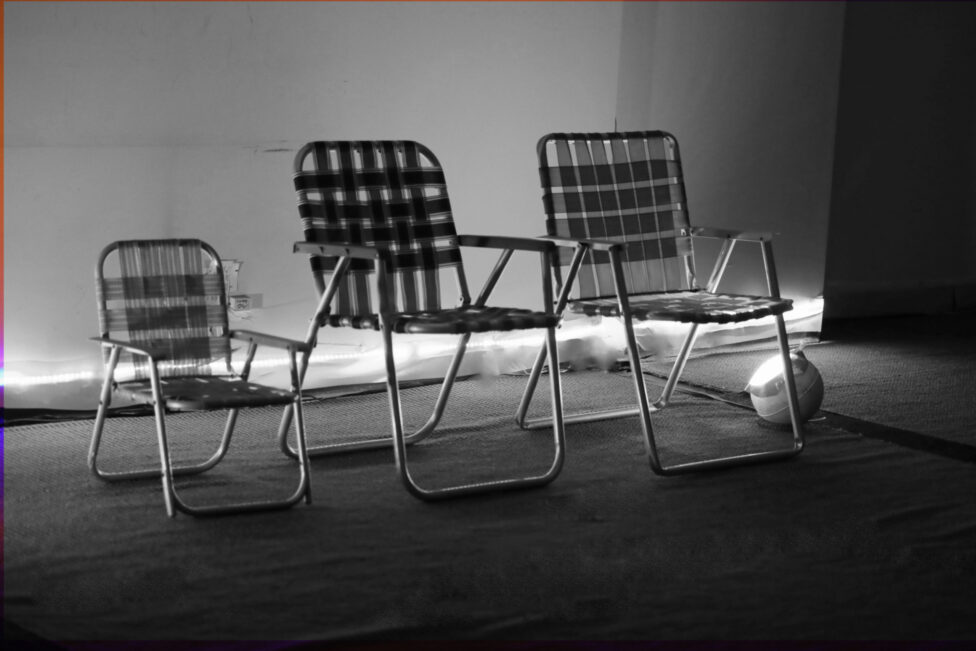Lisa Parra: I like how you work with the imagery. The imagery of the projections and live performance is pared down. Each scene says a lot. The way you insert yourself in the projected scene gives it another dimension and adds information. It’s like you could be anywhere, but it’s not like anywhere. You’re in a wonderful sunny…place.
Karen Bernard: It turned out to be both sunny and dark. The space had to be dark to see the projections. Even when I presented the video and live performance in Portugal, it was nighttime and I was wearing sunglasses. The projections were all created at daytime. We can think of it as a poolside party.
LP: In the evening, it’s more like a poolside cocktail party. You’re wearing sunglasses and the places are dark, but I didn’t realize you had performed at night in Portugal.
KB: The directors of the Obras Foundation invited friends from the surrounding area to visit artists’ studios. I scheduled Poolside last so that it would be dark. The residency is really fantastic. The directors are invested in supporting the artists’ projects with hands-on help, matching workspace, and organizing events. I had a studio and outdoor space. The first outdoor space was an empty concrete water tank. It would have been fantastic, except for the mosquitoes. I changed my location to a large courtyard with a tall, whitewashed building that I could project onto. It was like being at a drive-in. The crowd was exuberant.
LP: Wow!
KB: The resident artists were mostly visual–painters and mixed media–and composers/musicians, working inside and outside. I started creating the piece when it was very warm. Toward the end, it was like, fifty degrees with the wind howling. It was freezing. I am just glad it wasn’t raining, as we had just experienced torrential rains after 123 days of no rain. You can hear the wind in the present sound score.
LP: Everyone clapping and the laughter, that’s from your Obras performance?
KB: Yes, they were a really animated audience. I was taken aback by the laughing. And in this new version at Chashama I incorporated the Obras audience’s response. Now the audience has to process the laughing score one step removed. Are they laughing with me, at me, or they just can’t figure it out–it hovers somewhere in between. I like it when people are on the fence about whether something’s funny.
LP: I think of it as more of a twist or comment on itself. Taking something and flipping it. It keeps you from going into a comfortable zone. It could go either way. You often work with ambiguity. Your body is your landscape…body and skin.
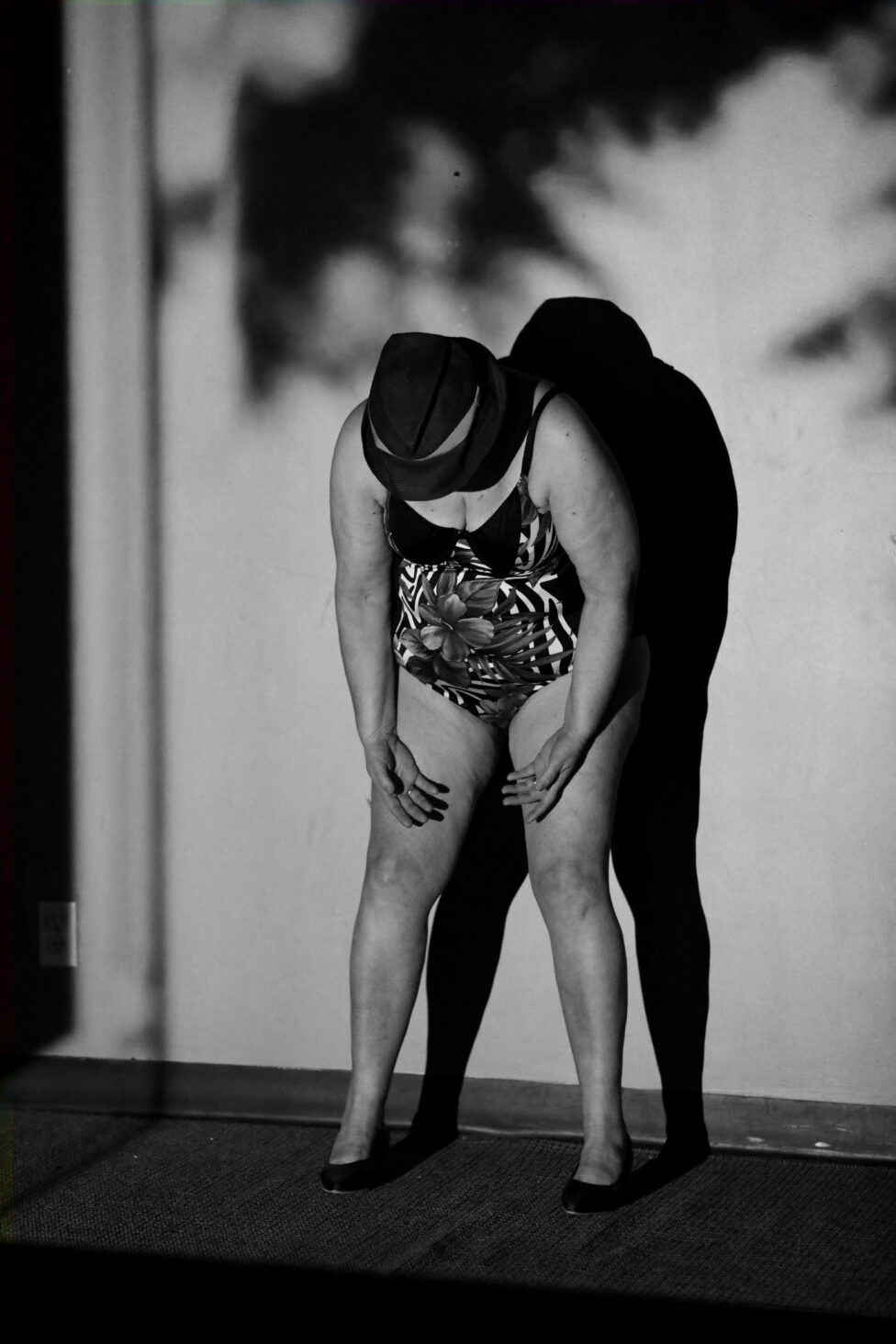
Karen Bernard, Poolside, Photo By Kathryn Butler
KB: I’m trying to come to terms with the fact that my body is like, in decline. In the videos, you see close-ups of every pore, and it’s a little frightening to look at myself. I sometimes pretend it’s not me! That’s me?
The video images of me from far away are flattering. You do not see the imperfections. I toy with exposure and vulnerability. Audiences think I am brave. It is always difficult for me in the beginning. But I am in control. I have made a choice to let people see, and in the end the performance empowers me. I have had women of different ages come up to me and share, “I wanted to get up and dance with you” or “I bought a bathing suit the other day. I wish I had seen this performance first.”
LP: It’s interesting that you say that your body changes as you get older. In my body, it wasn’t the same when I was in my twenties or even early thirties. Then you start to notice these things. It’s like there’s a sense of acceptance of it, right? When you project close-ups of skin, it becomes more like a landscape than a body. But it has another peculiarity about it, that’s more…
KB: Almost abstract.
LP: Yes, like it is something else. So you detach yourself…
KB: Yes! Exactly!
LP: …from this older woman’s body. In our society, everyone makes such a big deal about trying to keep a perfect sensibility of what a body should be.
KB: As I get older, what I desire becomes complicated. And day to day I adjust what I want, what is meaningful to me, and my trajectory in life. I have selective memory that I can relive vividly.
LP: You use old photographs. Are those of you?
KB: That’s my mother. I went through my mother’s things when she passed and came across many great photographs. The one of my mom standing by a pool inspired me. I hadn’t anticipated using the photo, but when I started thinking about the pool and my mom, it came together for me. I don’t have a picture of her at my age at the pool, so I created a photo of myself embodying her pose. She was probably in her 40s. A marked difference to my 70 years.
The bathing suit became central to Poolside. I knew there would be a pool at the residency, so I took along this fun made-for-me bathing suit and ended up using it as a costume. I always work in my costume, once I have it. And I stay with it, because I feel the costume is part of the performance, and influences the way I move and internalize emotion. I never could understand how people could make a work and then get the costume. Well–it’s based on the work that they’ve made. But I’ve always felt that a costume was necessary for the process.
LP: So you always think of a costume first?
KB: It depends. Sometimes the costume idea develops as the work develops. It’s the visual art part of me kicking in.
LP: I can see that. Did you already have in mind that Poolside would be based on the bathing suit?
KB: No, I went there and I didn’t know what the hell I was going to do. I prefer to give very loose ideas when I apply for a residency, because I like experiencing the environs and not knowing. It’s exciting to have no idea what you’re doing!
LP: That’s true.
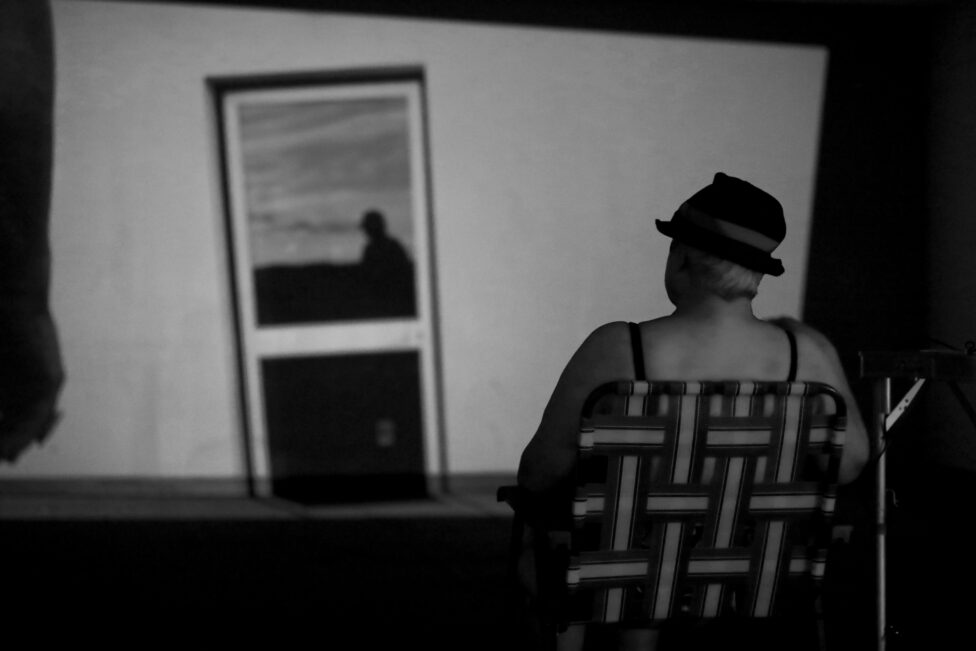
Karen Bernard, Poolside, Photo: Kathryn Butler
KB: As it turned out, I was kind of like “Ugh!” Scott, my husband, was with me. He applied separately, and he was painting up a storm–almost a painting a day. He was extremely prolific, working every day and enjoying it. While I didn’t know what the hell I was doing. And in the video, you see me just sitting around and having coffee. I thought “Oh, I’m just going to sit around and enjoy the sun!” But then I decided to start videotaping myself doing mundane everyday activities. It started to build from there. I gathered a lot of footage. Some was used for the video/live performance and other footage was used for the Chashama installation.
I loved the doors and going in and out of the dark to the light. I’m always amazed at how I can think of an idea. Just sitting around, and some idea will come to me to try out. I always think about how when I was young, I didn’t know how to play. I wasn’t good at that. I didn’t have a good imagination. To play with dolls, or anything, you know? And now, I feel that I can play.
LP: It comes back, I don’t know. I get that, I like playing. I can play all the time. But the idea of play is subjective…. Also, I like the fact that you don’t have anything particular in mind, that’s really liberating. Then you don’t have pressure. You can sit there, either inspired by the environment or the people or something. I think that’s always a very good approach. What about that one over there?
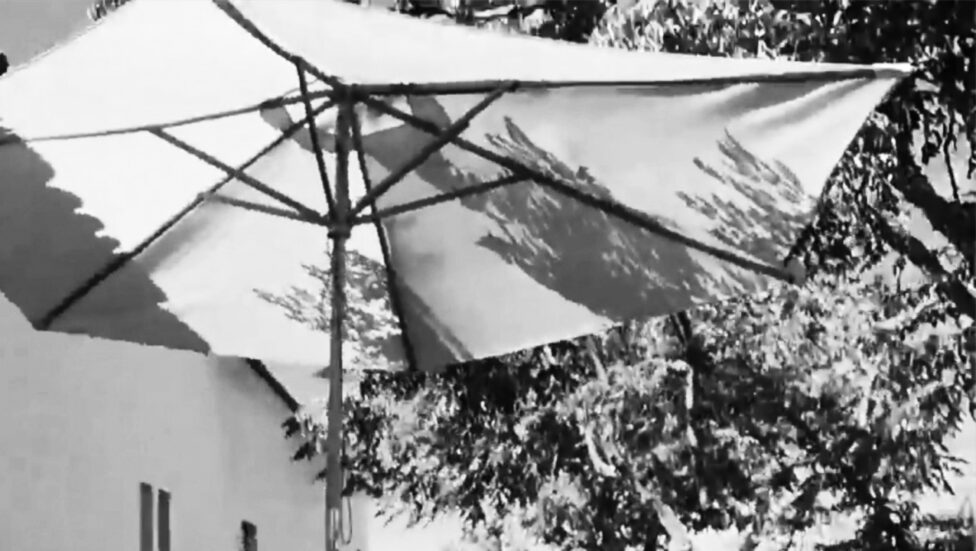
Karen Bernards, Poolside, Video Still
KB: That’s the umbrella, outside of our apartment. We had a little patio and an umbrella, all on one level. Scott would often paint out there, until it started to get too cold. Although the umbrella is not near the pool, it looks really poolside.
LP: It does look poolside. And it does look like you’re somewhere in the south of Europe.
KB: This space was a challenge–twenty-two hundred square feet of ugly space. I tried to create a cozy environment. I brought in vintage beach chairs, projections of sparkling water, and ambient sound. With the help of Emma Rivera’s clever lighting, we transformed the space. We created an environment that embraced the performance. It was the first time I’ve ever done anything like this.
LP: It’s great. It’s a minimalist approach. You’re not using a lot of high tech. You have created a space or situation that tries to be a sunny summer day, but it’s actually really cold. It’s super cold!
KB: The small soundscape room was, for some, a place to rest and let their minds wander. But I saw kids playing in it–two boys tackling each other. My son, Than, took his one-year-old daughter there because she started laughing so hard during the performance. At first, her laughter was genuine–there are some funny bits. But when the audience responded to her laughter, it egged her on, and she kept pretending to laugh. When Than took her into the room he looked out of the window to see the performance. He couldn’t tell if it was video or live performance. I thought that was interesting, as I walk into the video to perform for 10 minutes out of the 30 minutes.
LP: You’ve created a different duality and dimension.
KB: At first the live performance was only five minutes.
LP: Only five?
KB: Yes, then I added another five. Its vocabulary is feminine as seen in movies and jazz routines, along with natural, almost grotesque posturing of various vantage points of my body. I improvise using this palate of vocabulary. I used to choreograph and set every single movement and gesture from my head to my eyes to my toes and fingertips–practice it over and over again, like I’d be afraid to improvise. Now I do not have the patience to set work and find that it’s fresh and internalized with I improvise.
LP: I know what you’re saying. It is hard. I don’t know about you, but I just have a hard time. You know, you improvise, and when you start to create something–to get some movement sequence, themes, or whatever going, I have a hard time remembering. It’s just so weird. There are sometimes when it’s like, “Oh my god, that felt good. I should go with that.” But then I can’t remember how exactly I did that.
KB: Do you videotape yourself all the time?
LP: I do! Not all the time.
KB: But sometimes.
LP: And even so, when I think I’m really interested in something, I go back and I think “Eh, not so great.” I don’t know.
KB: Yes, that reminds me of when I was videotaping myself sitting around or just going in and out of a doorway. Later on, I would try to do it again. I thought, “Well, I could do this better!” But it was never as good as the first time. Right?
LP: It doesn’t feel the same. Sometimes, you go back and it doesn’t feel the same way at all.
KB: The first time is always the best. The first taping, when I didn’t know exactly what was going to happen, was the best.
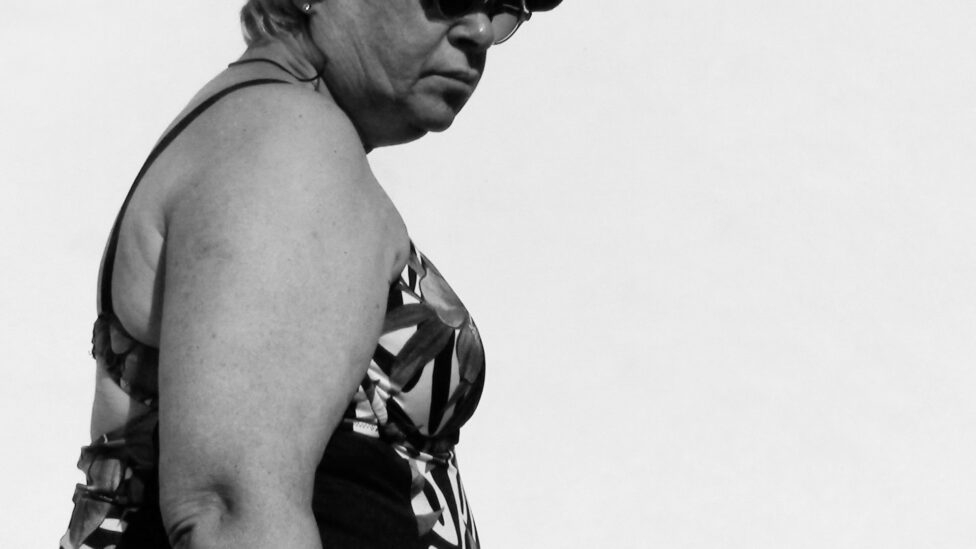
Karen Bernard Poolside (video still)
Development of Poolside was made possible through the Obras Foundation and Chashama.

